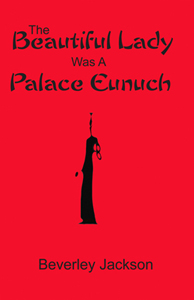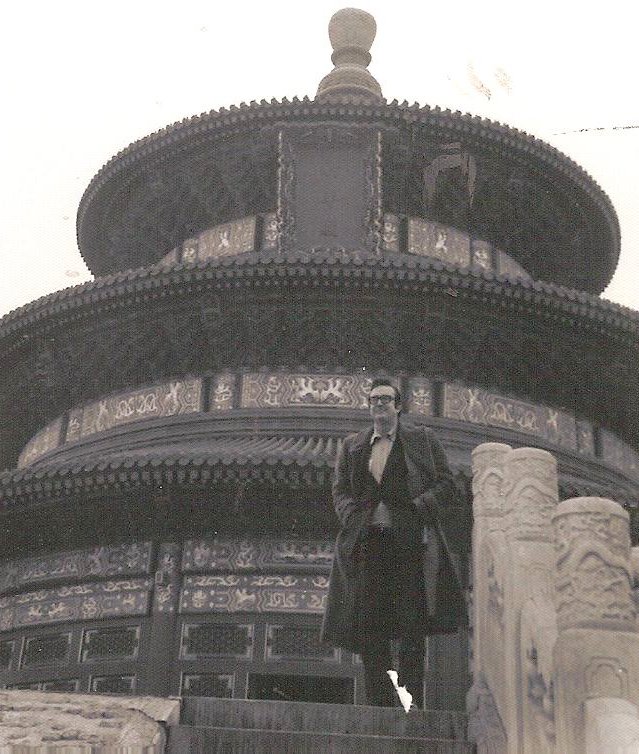Chapter Ten
THE SUMMER PALACE BLANKETED WITH SNOW
There had been snow flurries the day we visited the Summer Palace. Our visit was at a time when the royal family would have been in residence in the Forbidden City in Peking, not the Summer Palace. During the imperial era this was a summer escape spot for the royal entourage from Peking heat that could soar to 104 degrees Fahrenheit with very high humidity. The small umbrella pines lining the road to the palace were dusted with snow. Bicyclists were generally dressed in the same cotton padded Mao suits that appeared to be inadequate for the extreme cold but somehow worked. Men from the north heading into the city wearing Mongolian fur hats with ear flaps and sheepskin clothing, driving large horse drawn wagons filled with loose hay or great balls of rope were more suitably dressed.
We passed what our contrary cadre guide called a gymnasium. A more adequate explanation was not forthcoming however we assumed it might be a prison. Outside in the snow more than 100 men standing in precise rows did exercises waving red flags. Since this waving of red flags was a common practice in China during the Cultural Revolution it wasn’t a clue to what the gymnasium actually was. However, a few days later in Tien en mien square I was to remember this flag waving performance.
In that legendary world long gone the royal court could actually reach their summer palace refuge by canals that led from the Forbidden City northeast to the Summer Palace. The lovely lake at the palace has always been fed from streams which in turn feed into the canals. The lake was partially frozen over the day we visited, presenting a gray and white mystical scene, accented by the bright red tile roofs of the Palace of Orderly Clouds on the shore and far away scarlet bridges faintly visible through the mist.
Looking far out across K’un-ming Lake, Steve and I wondered about dark spots on the ice that appeared to very large birds. Our tour guide for the day, a particularly unpleasant man, was determined to impress us with Maoism and the Cultural Revolution unceasingly. Any minor question was answered with a party speech. But I plunged right in and asked him if the birds far out on the ice were some form of penguin.
“Those are not birds,” he practically screamed at me. “Those are markers put there by the Chinese People’s Liberation Army to keep the children from falling through the thin ice.”
“I don’t care what that guy says,” Steve whispered. “I just saw one of his markers lay an egg!”
The rigid Stalinesque geometric architectural designs of the new Russian built buildings in Peking were in direct contrast to the lovely rambling scheme of the Summer Palace. The Garden of Pleasant Harmony flows into the Palace of Virtue and Harmony where theatre was performed for the joy of the all-powerful last dowager empress Tz’u-hsi who ruled China from 1861 until her death November 15, 1908. She delighted in anything of dramatic, theatrical nature.
The stage several stories high had the capability of bringing fantastic sets up from below or having a great deal going on in heaven overhead. And on many occasions the dowager empress herself had appeared in performances for the enjoyment of the royal family. Her favored role was that of the beloved Goddess of Mercy Kuan-yin. On these days it was presumed she wasn’t having princesses thrown down wells to die, or poisoning relatives, which she was known to do on off days. A favorite story that emerged from her court detailing one such bad day concerned a new eunuch who was called in to dress the empress’s hair. The eunuch hairdresser who always attended to the elaborate imperial coiffeur was ill. In a state of nervous terror at this task trust upon him unexpectedly the stand-in hairdresser accidentally pulled a couple of hairs out while combing the long black hair. The enraged dowager empress ordered him to put them back in immediately or he would be beheaded. The problem with this story, repeated for decades, is that no one knows the outcome.
We nestled into our fur coats and dug our mitten covered fingers deep into pockets for extra warmth as we strolled the famous open Long Corridor beside the lake. This elaborately painted meandering walk is a treasury of more than 8,000 paintings. It was originally built in 1750 by the Qing dynasty’s Qianlong emperor (1736-1795) so that his mother could enjoy the gardens of the Summer Palace without concern for the elements. Following the destruction of the fascinating structure by Anglo-French allied forces in 1860 it was rebuilt in 1886. The Chinese say that the Long Corridor on K’un-ming Lake is long enough (2,366 feet long) to speak the first words of love at one end, and be engaged to marry by the other end. I lingered extra chilling minutes examining an overhead beam painting of a mother panda carrying her baby through a bamboo forest with classical Chinese mountains beyond.
An adjoining covered gallery looks upon the aquatic garden in the lake. Imaginative windows shaped like bats, stars, fans, medallions, all outlined in strips of red and black lacquer, break through the stark white walls of this enclosed walkway. These are double windows, with paintings on the inside glass. Enjoying the unique windows Jayne was reminded of a window treatment Marge had used on an interior decorating job in Beverly Hills.
“Marge, do you remember what you did in Danny Melnick’s bedroom?” Jayne called innocently to Marge who was at the other end of the long gallery. The Chinese missed the hidden humor of this question and didn’t laugh. The sexual innuendo was totally lost on them. But our group of Americans found it most amusing.
The snow had stopped by the time we reached the Temple of Heaven, one of the most frequently visited sights in China. It is the three-tiered Altar of Heaven whose bright blue tiled roof shone strangely in the unusual light that followed the disappearing clouds dispensing snow. There are actually three tiled roofs pile on top of each other looking quite like a three-tired blue Chinese summer hat.
While we quietly admired it in the context of a Ming creation utilized by the theatrically clad emperor (who wore special blue robes, not imperial yellow for his performances at the Altar of Heaven), our guide droned on about this great example of chairman Mao’s directive to “Let the Old Serve the New”. Now the people of China walk the marble paths where only the emperor and his entourage trod in the era past. However, this is the one place where this living god, the emperor, was humble. He came here once a year in his role as the Son of Heaven, taking upon himself the sins of all his people, prostrating and humiliating himself for the redemption of mankind.
This humble attitude only struck once a year. Escorted by soldiers, officials and princes of royal blood, he went from the Forbidden City to the Temple of Heaven in an anything but humble procession. Every window along the route had to be covered, from the gate of Ch’ien Men to the entrance of the sacred temple area. This was due to the very strict laws that no one was allowed to look upon the face of this man who was about to be humble. Even foreign diplomats were strongly advised to stay indoors on the day of this journey from the Forbidden City to the Temple of Heaven.
Chapter 1: Part 1 Part 2
Chapter 2: Part 1 Part 2 Part 3
Chapter 3: Part 1 Part 2 Part 3 Part 4
Chapter 4: Part 1
Chapter 5: Part 1 Part 2 Part 3
Chapter 6: Part 1 Part 2 Part 3
Chapter 7: Part 1
Chapter 8: Part 1 Part 2
Chapter 9: Part 1 Part 2
Chapter 10: Part 1
Chapter 11: Part 1 Part 2
Chapter 12: Part 1
Chapter 13: Part 1

This blog was started to sell my new book and I keep going off on other topics. Please do check out The Beautiful Lady Was A Palace Eunuch
Kathleen Fetner, Technical Advisor and Friend



Beverly: how i adored reading this one, (just before running out) + love the descriptions of the place. will pass it on when i get back. xxpeggybraswelldesign.com